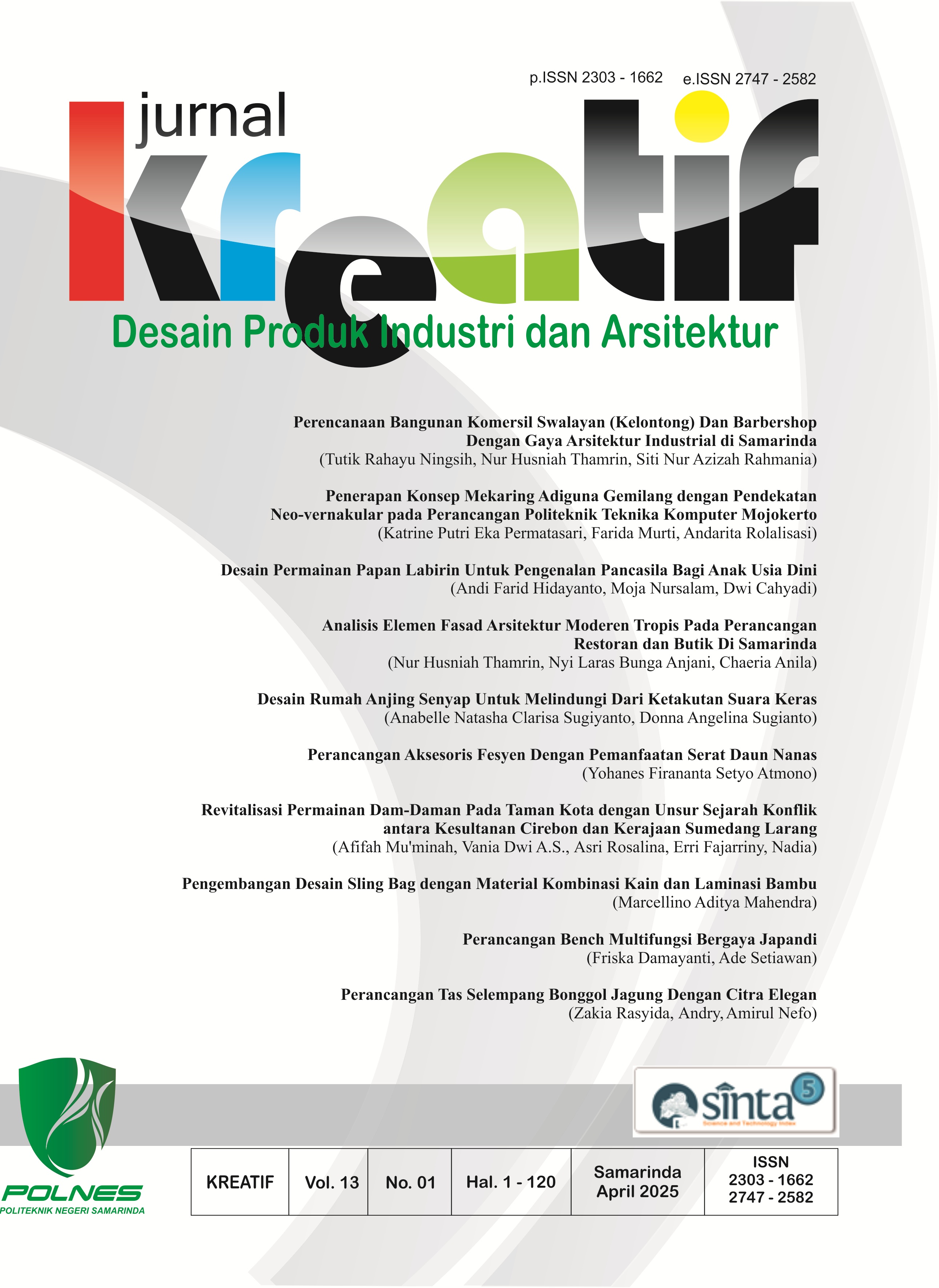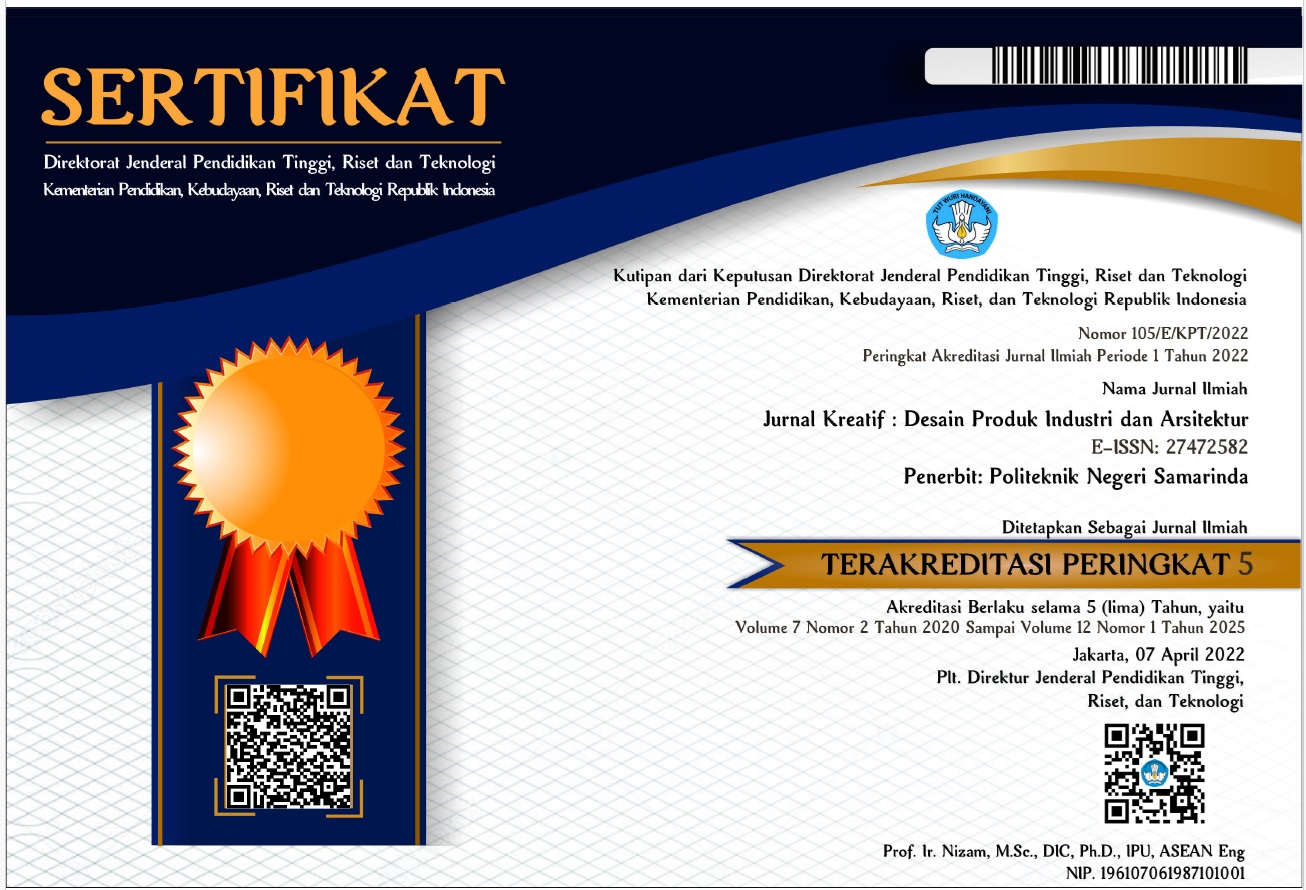REVITALISASI PERMAINAN DAM-DAMAN PADA TAMAN KOTA DENGAN UNSUR SEJARAH KONFLIK ANTARA KESULTANAN CIREBON DAN KERAJAAN SUMEDANG LARANG
 Abstract views: 36
,
Abstract views: 36
,
 PDF downloads: 23
PDF downloads: 23
Abstract
Children love to play, but with the rapid development of information technology there has been a change in the way children play. From playing directly and socializing with friends, to playing through gadgets. This makes children gradually lose their skills in socializing and playing with their friends. Dam-daman is a traditional game that has begun to be less known in the community. Researchers revitalized the game of checkers as a form of play that motivates children to play outside and socialize. The research was conducted by implementing the ATUMICS method. The transformation of the checkers game tradition is carried out by identifying using the ATUMICS table. Thus, the design of checkers games in public spaces is produced that allows children to interact and can motivate other visitors to public spaces, not only children. Thus, the dam-daman game can be preserved and also the content about its history is known by the public.
Downloads
References
Girsang, M. B., & H, R. (2021). DESAIN PERMAINAN 3D PUZZLE DENGAN BENTUK HEWAN KHAS KALIMANTAN. Jurnal Kreatif: Desain Produk Industri Dan Arsitektur, 9(1), 44-51. doi:https://doi.org/10.46964/JKDPIA.V9I1.148
Gottman, J., Gonso, J., & Rasmussen, B. (1975). Social Interaction, Social Competence, and Friendship in Children. Child Development, 46(3). doi:https://doi.org/10.2307/1128569
Hartono, S. (2011). Batik Pesisir Pusaka Indonesia. Jakarta: Kepustakaan Populer Gramedia.
Mahdar, A. M. (2008). Pakarang Sumedang Larang”: Kajian Estetik, Fungsi dan Makna Simbolik Desain Senjata Tradisional Peninggalan. Bandung: Institut Teknologi Bandung.
Nugraha, A. (2012). Transforming tradition: A method for maintaining tradition in craft and design context: Aalto University.
Nurhidayat, M., & Herlambang, Y. (2018). Visual Analysis of Ornament Kereta Paksi Naga Liman Cirebon. Bandung Creative Movement (BCM) Journal, 4(2).
Papanek, V. (1985). Design For The Real World. In Design for the real world (Issue March).
Ramlan, A., & Bahalwan, H. (2021). DESAIN PERMAINAN PAPAN UNTUK MENGENAL RUMAH DAN PAKAIAN ADAT PADA ANAK PRASEKOLAH. Jurnal Kreatif : Desain Produk Industri dan Arsitektur, 9(1), 24-35. doi:https://doi.org/10.46964/JKDPIA.V8I2.145
Sapto, Y. H., Suci, A., & Ratih, P. (2019). Pengembangan Permainan Papan (Board Game) Edukatif Sebagai Media Promosi Kesehatan Gigi dan Mulut pada Anak Usia Sekolah. Sport Science and Health I, 1(2). Retrieved from http://journal2.um.ac.id/index.php/jfik/indexhttp://fik.um.ac.id/
Sofiyawati, N. (2018). Kajian Estetik Kereta Kencana Singaborang dan Paksi Naga Liman Kerajaan Cirebon. Bandung: Institut Teknologi Bandung.
Sumardjo, J. (2006). (Estetika Paradoks: Sunan Ambu.
Syukur, A. (2019). Wawancara dengan Pengelola Museum Prabu Geusan Ulun.
Tjandrasasmita, U. (2009). Arkeologi Islam Nusantara. Jakarta: Kepustakaan Populer Gramedia.
Copyright (c) 2025 Afifah Muminah, Vania Dwi A. S. , Asri Rosalina, Erri Fajarriny, Nadia

This work is licensed under a Creative Commons Attribution-ShareAlike 4.0 International License.
Authors who publish with this journal agree to the following terms:
- Copyright on any article is retained by the author(s).
- The author grants the journal, right of first publication with the work simultaneously licensed under a Creative Commons Attribution License that allows others to share the work with an acknowledgment of the work’s authorship and initial publication in this journal.
- Authors are able to enter into separate, additional contractual arrangements for the non-exclusive distribution of the journal’s published version of the work (e.g., post it to an institutional repository or publish it in a book), with an acknowledgment of its initial publication in this journal.
- Authors are permitted and encouraged to post their work online (e.g., in institutional repositories or on their website) prior to and during the submission process, as it can lead to productive exchanges, as well as earlier and greater citation of published work.
- The article and any associated published material is distributed under the Creative Commons Attribution-ShareAlike 4.0 International License













